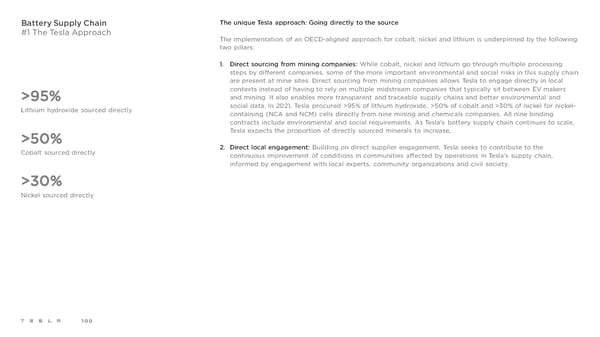Battery Supply Chain The unique Tesla approach: Going directly to the source #1 The Tesla Approach The implementation of an OECD-aligned approach for cobalt, nickel and lithium is underpinned by the following two pillars: 1. Direct sourcing from mining companies: While cobalt, nickel and lithium go through multiple processing steps by different companies, some of the more important environmental and social risks in this supply chain are present at mine sites. Direct sourcing from mining companies allows Tesla to engage directly in local contexts instead of having to rely on multiple midstream companies that typically sit between EV makers >95% and mining. It also enables more transparent and traceable supply chains and better environmental and Lithium hydroxide sourced directly social data. In 2021, Tesla procured >95% of lithium hydroxide, >50% of cobalt and >30% of nickel for nickel- containing (NCA and NCM) cells directly from nine mining and chemicals companies. All nine binding contracts include environmental and social requirements. As Tesla’s battery supply chain continues to scale, . >50% Tesla expects the proportion of directly sourced minerals to increase Cobalt sourced directly 2. Direct local engagement: Building on direct supplier engagement, Tesla seeks to contribute to the continuous improvement of conditions in communities affected by operations in Tesla’s supply chain, informed by engagement with local experts, community organizations and civil society. >30% Nickel sourced directly 100
 Tesla 2021 Impact Report Page 99 Page 101
Tesla 2021 Impact Report Page 99 Page 101